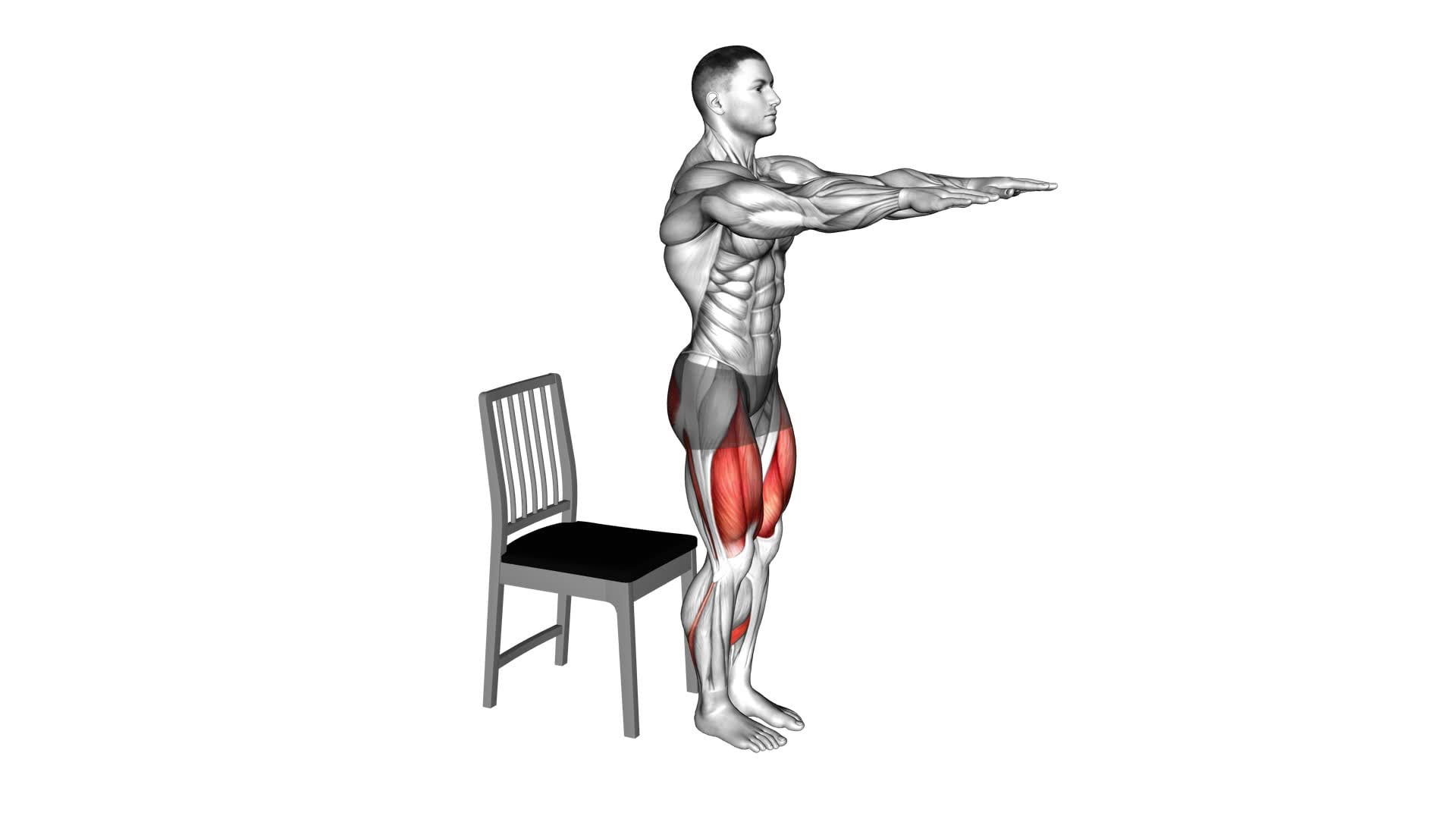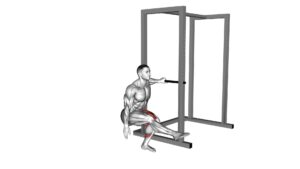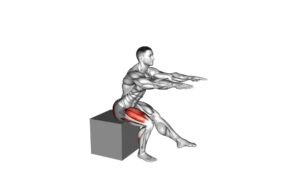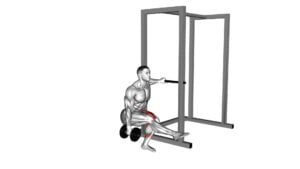Pistol Squat With Chair – Video Exercise Guide & Tips

Are you looking for a challenging lower body exercise that can be done at home? Look no further than the pistol squat with a chair!
Watch This Exercise Video
This video exercise guide will show you the proper form and technique to master this advanced move.
Learn how to set up the chair for maximum stability and avoid common mistakes.
With progressions and variations, as well as tips for a safe and effective workout, you'll be on your way to stronger legs in no time.
Key Takeaways
- Pistol squats strengthen multiple muscle groups simultaneously, including the quadriceps, hamstrings, glutes, and core muscles.
- Proper form and technique are crucial, including maintaining a neutral spine, engaging the core, aligning the knee with the toes, and focusing on chest lifted and shoulders back for a neutral spine.
- Setting up the chair correctly is important, with the chair height adjusted to parallel the thigh to the ground when seated and ensuring chair stability.
- Stability and balance play a significant role in the exercise, with the chair placed on a flat and non-slip surface, positioned at a comfortable distance from a wall or support, and adjusted for optimal stability and balance.
Benefits of the Pistol Squat
One key benefit of the pistol squat is that it strengthens multiple muscle groups simultaneously. This exercise primarily targets the quadriceps, hamstrings, glutes, and core muscles. By performing pistol squats, you can effectively engage these muscle groups, leading to increased strength and stability in your lower body.
One advantage of using a chair modification for pistol squats is that it provides support and stability for those who may struggle with balance or have difficulty performing the exercise without assistance. By using a chair, you can gradually build up strength and confidence before progressing to the full pistol squat. This modification allows you to focus on proper form and technique while still activating the targeted muscle groups.
Muscle activation is a significant benefit of the pistol squat. This exercise requires a high level of stability and control, which leads to increased muscle activation throughout the entire lower body. Not only does it strengthen the larger muscle groups, but it also activates the stabilizing muscles in the hips, knees, and ankles.
In order to perform pistol squats with proper form and technique, it's essential to maintain a neutral spine, engage the core, and keep the knee aligned with the toes. Transitioning smoothly from the chair modification to the full pistol squat will require practice, patience, and consistent effort.
Proper Form and Technique
To perform the pistol squat with proper form and technique, you need to focus on maintaining a neutral spine, engaging your core, and keeping your knee aligned with your toes. This exercise is great for improving flexibility and strengthening your leg muscles.
First, start by standing in front of the chair with your feet hip-width apart. Extend one leg forward, keeping it straight and parallel to the floor. Slowly lower yourself down into a squat position, while keeping your other leg elevated in front of you.
As you lower yourself, make sure to keep your knee aligned with your toes and avoid any inward or outward movement. This will help prevent any unnecessary strain on your knee joint. Additionally, engage your core muscles to maintain stability and support your lower back.
Throughout the movement, focus on maintaining a neutral spine by keeping your chest lifted and your shoulders back. This will help to activate your glutes and prevent any rounding of your back.
Setting up the Chair for the Exercise
To set up the chair for the exercise, start by adjusting the height to a level that allows your thigh to be parallel to the ground when seated.
Ensure that the chair is stable and won't wobble during the exercise.
Position the chair in an open space, facing forward, with enough room for your extended leg to move freely.
Chair Height Adjustment
Adjust the height of the chair to a comfortable level before starting the pistol squat exercise. This is important for maintaining proper form and preventing injury.
Here's how to set up the chair for the exercise:
- Position the chair so that it's stable and won't wobble or tip over during the exercise. Make sure all four legs are firmly on the ground.
- Adjust the height of the chair so that when you sit on it, your thigh is parallel to the ground. This will allow you to perform the pistol squat with the correct range of motion.
- Test the chair by sitting on it and performing a few squats to ensure that it feels stable and secure. If you feel any wobbling or instability, adjust the height or position of the chair until it feels comfortable and secure.
Stability and Balance
Before you begin the pistol squat exercise, ensure that the chair is set up for optimal stability and balance. This is crucial for improving stability and engaging your core effectively during the exercise.
First, make sure the chair is placed on a flat and non-slip surface. This will prevent any unnecessary movement or sliding during the squat.
Next, check that the chair is positioned at a comfortable distance from a wall or any other support that you may need for balance.
Adjust the chair height so that when you lower yourself into the squat position, your thigh is parallel to the ground. This will help you maintain proper form and prevent any strain on your knees.
Chair Placement Tips
Ensure optimal stability and balance for the pistol squat exercise by properly setting up the chair. Follow these chair placement tips to enhance your workout:
- Position the chair parallel to a wall, ensuring it's stable and doesn't wobble. This will provide support and prevent any accidental tipping.
- Place the chair just behind you, with the backrest facing away. Make sure the chair is at a comfortable distance from your starting position.
- Align your feet with the edge of the chair, keeping them hip-width apart. This will provide a stable base for your squatting motion.
By following these chair placement tips, you can ensure proper chair stability and positioning, allowing you to perform the pistol squat exercise safely and effectively.
Now, let's move on to the next section and discuss common mistakes to avoid.
Common Mistakes to Avoid
When performing the pistol squat with a chair, there are common mistakes that you should avoid.
One mistake is having an unstable chair positioning, which can lead to poor form and potential injury.
Another mistake is neglecting to warm up and stretch beforehand, which can result in muscle strains or pulls.
Unstable Chair Positioning
To avoid making common mistakes and maintain stability during the pistol squat with chair exercise, it's important that you position the chair securely and firmly. Here are some tips for achieving optimal chair stability and positioning:
- Place the chair on a flat and non-slip surface to prevent it from sliding or wobbling during the exercise.
- Ensure that all four legs of the chair are in contact with the ground to provide a stable base of support.
- Position the chair slightly behind you, allowing enough space for your extended leg to move forward without hitting the chair.
By following these guidelines, you can ensure that the chair remains stable throughout the pistol squat exercise, reducing the risk of injury and allowing you to focus on proper form and technique.
Now let's move on to the next section, which discusses the importance of adequate warm-up and stretching beforehand.
Inadequate Warm-Up/Stretching Beforehand
Are you adequately warming up and stretching beforehand to avoid common mistakes during the pistol squat with chair exercise?
Proper warm-up and stretching are crucial for injury prevention and optimizing your performance during any exercise. Before attempting the pistol squat with chair, it's important to prepare your body by increasing blood flow to your muscles through light cardiovascular activity, such as jogging or jumping jacks.
Additionally, dynamic stretches that target the muscles involved in the pistol squat, such as the quadriceps and hip flexors, can help improve flexibility and range of motion. By incorporating a thorough warm-up and stretching routine into your workout, you can reduce the risk of injury and enhance your overall performance.
Now, let's move on to the next section and explore progressions and variations of the pistol squat with chair exercise.
Progressions and Variations
To increase the difficulty and target different muscle groups, try incorporating various progressions and variations into your pistol squat with a chair exercise. Here are three options to help you challenge yourself and continue making progress:
- Elevated Pistol Squat: Place your back foot on a raised surface, such as a step or sturdy block, while performing the pistol squat. This increases the range of motion and requires more strength and stability in your working leg.
- Weighted Pistol Squat: Hold a dumbbell or kettlebell in front of your chest while performing the pistol squat. The added resistance increases the load on your muscles, making the exercise more challenging and helping to build strength.
- Single-Leg Box Squat: Instead of using a chair, use a box or bench that's slightly lower than knee height. Stand in front of the box with one leg extended in front of you, then slowly lower yourself down onto the box with your standing leg. This variation targets the same muscles as the pistol squat but places more emphasis on your glutes and hamstrings.
Remember to always listen to your body and choose the progression option or modification that's appropriate for your fitness level. By incorporating these variations, you can continue to challenge yourself and make progress in your pistol squat with a chair exercise.
Tips for a Safe and Effective Workout
For a safe and effective workout, prioritize proper form and technique while performing the pistol squat with a chair exercise. Proper form is essential to prevent injury and maximize the benefits of this exercise. When performing the pistol squat with a chair, keep your chest up, spine neutral, and knees aligned with your toes. Engage your core and glutes throughout the movement to maintain stability.
In addition to proper form, proper breathing technique is also important during the pistol squat with a chair. Breathe in as you lower yourself down, and exhale as you push back up. This will help stabilize your core and provide the necessary oxygen to your muscles.
To ensure safety and effectiveness, it's recommended to start with a frequency of 2-3 times per week. This allows your muscles to recover and adapt to the demands of the exercise. As you progress and become more comfortable, you can increase the frequency to 4-5 times per week.
Remember, it's important to listen to your body and not push yourself too hard. If you experience any pain or discomfort, stop the exercise and consult with a healthcare professional.
Frequently Asked Questions
How Many Sets and Repetitions Should I Do When Performing the Pistol Squat With a Chair?
When performing the pistol squat with a chair, it's important to focus on proper form and gradually increase the difficulty. Start with a few sets of 5-8 repetitions and gradually work your way up.
This exercise is great for building lower body strength and stability. By using a chair for support, you can work on your balance and gradually progress to performing the pistol squat without assistance.
Keep challenging yourself and enjoy the benefits of this exercise.
Can I Use a Different Type of Chair if I Don't Have the Specific One Mentioned in the Article?
Yes, you can use a different type of chair if you don't have the specific one mentioned in the article. Using a chair in the pistol squat exercise can provide stability and support, making it easier to maintain balance and perform the movement correctly.
Different chair alternatives, such as a sturdy stool or bench, can also be used to achieve similar benefits. Just ensure that the chair you choose is stable and can support your weight.
Are There Any Modifications for the Pistol Squat With a Chair for Individuals With Knee or Hip Issues?
If you're dealing with knee or hip issues and want to modify the pistol squat with a chair, there are a few options.
You can try using a higher chair or bench to reduce the range of motion.
Another modification is to use a resistance band for assistance, providing support as you lower and lift yourself.
These modifications can help alleviate strain on your knees and hips while still benefiting from the overall lower body strength that the pistol squat with a chair offers.
Can I Incorporate Weights or Resistance Bands Into the Pistol Squat With a Chair Exercise?
Yes, you can definitely incorporate weights or resistance bands into the pistol squat with a chair exercise. Adding resistance bands to the movement can help increase the intensity and challenge your muscles even more. It can also help improve your strength and stability.
Incorporating weights, such as dumbbells or kettlebells, can further enhance the workout by adding resistance and increasing the load on your muscles. This can lead to greater muscle growth and strength gains.
How Often Should I Incorporate the Pistol Squat With a Chair Into My Workout Routine for Optimal Results?
To achieve optimal results and prevent injuries, it's important to incorporate the pistol squat with a chair exercise into your workout routine wisely.
The frequency of this exercise depends on your fitness level and goals. Start by performing it 1-2 times per week and gradually increase the frequency as your strength and stability improve.
This exercise effectively activates multiple muscles, including your quads, glutes, and core.
Remember to prioritize proper form and listen to your body to avoid overtraining and promote muscle activation.
Conclusion
In conclusion, the pistol squat with a chair is a beneficial exercise that targets the lower body muscles, improves balance, and increases overall strength.
By maintaining proper form and technique, setting up the chair correctly, and avoiding common mistakes, you can maximize the effectiveness and safety of this exercise.
Additionally, incorporating progressions and variations can help you continually challenge yourself and see progress.
Remember to always listen to your body and consult with a professional before starting any new exercise routine.

Author
Years ago, the spark of my life’s passion ignited in my mind the moment I stepped into the local gym for the first time. The inaugural bead of perspiration, the initial endeavor, the very first surge of endorphins, and a sense of pride that washed over me post-workout marked the beginning of my deep-seated interest in strength sports, fitness, and sports nutrition. This very curiosity blossomed rapidly into a profound fascination, propelling me to earn a Master’s degree in Physical Education from the Academy of Physical Education in Krakow, followed by a Sports Manager diploma from the Jagiellonian University. My journey of growth led me to gain more specialized qualifications, such as being a certified personal trainer with a focus on sports dietetics, a lifeguard, and an instructor for wellness and corrective gymnastics. Theoretical knowledge paired seamlessly with practical experience, reinforcing my belief that the transformation of individuals under my guidance was also a reflection of my personal growth. This belief holds true even today. Each day, I strive to push the boundaries and explore new realms. These realms gently elevate me to greater heights. The unique combination of passion for my field and the continuous quest for growth fuels my drive to break new ground.







